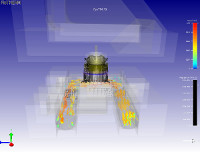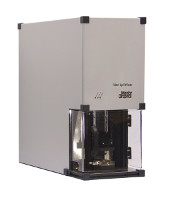An automated in-situ test method applied alongside Mentor's T3Ster platform can enable SSL product developers to design an optimal thermal management system that can ensure long life and maintained lumen output for LED-based products.
To keep LEDs at their optimal operating temperature range they must be cooled. Cooling is usually achieved by applying thermal interface materials (TIMs) that dissipate the generated heat. But which of the various TIMs is the optimal choice for a given application? Mentor Graphics used the LED professional Symposium + Expo 2013 in Bregenz, Austria to demonstrate an automated in-situ test method for characterizing TIMs.
Unlike incandescent lightbulbs, LEDs are semiconductors and thus must be kept cool. As an LED’s temperature increases, the light output decreases, the light changes color, and the lifetime of the LED is reduced. Temperature adversely affects both the functional performance of the LED and its longevity, so thermal management is a predominant issue in solid-state lighting (SSL) design.
When designing SSL products, thermal performance is a key consideration for creating a commercially successful product. Thermal performance of an electronic part is usually reported as thermal resistance, which is an indication of how difficult it is for heat to flow out of the package. Thermal resistance is calculated as the temperature rise of the junction divided by the power heating that junction. These metrics must be accurate because they are the primary inputs to thermal models used for design, and such a design must be fully characterized thermally.
The ASTM D-5470 test method is a standard method for the measurement of thermal resistance and bulk conductivity for TIMs but includes various disadvantages. Therefore, a new method based on existing measurement standards for a quick and repeatable thermal conductivity measurement of nanoparticle-based thermal greases and other compressible TIMs has been created by Mentor Graphics in collaboration with researchers at the Budapest University of Technology and Economics.
The new test approach is based on the thermal transient testing methodology, and test results clearly indicated that it can be applied well for measurement of the bulk thermal conductivity of TIMs. Beside the measurement of the bulk thermal conductivity, after a proper calibration step, the proposed setup is also suitable for the measurement of the effective thermal conductivity of various TIM samples. For highly conductive samples, the characterization is done with exceptional accuracy and repeatability.
Automated test setup for accurate industrial evaluation
Mentor Graphics further developed an automated measurement equipment to eliminate the errors originating from the manual settings and to demonstrate that the method is applicable for industrial use. The new TIM testing unit works together with Mentor T3Ster measurement system, which has high enough resolution to measure the temperature changes in the junction of a selected semiconductor at different bond line thickness (BLT) levels.
The resolution and the accuracy of the automated system are also higher than the values of the experimental tester. The resolution of the BLT setting is 0.1 μm, and the accuracy of the BLT setting is 1 μm to allow for the measurement of soft materials. The distance of the heater element and the cooling block can be set automatically with a servomotor that moves the semiconductor devices on a rail.

FIG. 1. Thermal simulations demonstrated that less than 3% of the heat-flux takes a different path than through the TIM.
An equivalent model of the tester's grips was prepared in FloTHERM (Fig. 1) to demonstrate that the heat-flux generated at the junction of the power semiconductor device goes through the grips of the tester and screens the TIM with sufficient efficiency, and then thermal simulations were made. The simulations demonstrated that the majority of the heat flows through the TIM — typically less than 3% of the heat-flux takes a different path. This percentage is kept nearly constant through the test process; therefore, it can be considered as an offset error in the thermal resistance readings, but it does not influence the measured bulk thermal conductivity values at all.
Automated TIM measurement methodology
The commercial outcome of this TIM testing methodology development is the DynTIM tester equipment (Fig. 2). Combined with the T3Ster test product, it provides the industry's most accurate method of measuring thermal resistance of TIMs on a variety of materials at different preset thickness levels, such as greases, pastes, phase-changing materials, and even specially prepared metallic samples. On average, the DynTIM tester provides TIM measurement accuracy by ±5% with the highest repeatability results, which the industry is currently lacking because most ASTM-based tests are conducted using in-house test systems.

FIG. 2. The DynTIM automated test system.
Engineers who use DynTIM can test a large number of different TIMs to create a short-list of the best performing materials as possible candidates for the application. After the measurement of the material properties and narrowed selection of the TIMs, T3Ster is capable of testing these materials in-situ, in their target environment, for the best possible design decision. This solution is ideal for the manufacturers of semiconductor, electric appliance, and materials markets where controlled manufacturing of materials performance is critical.




